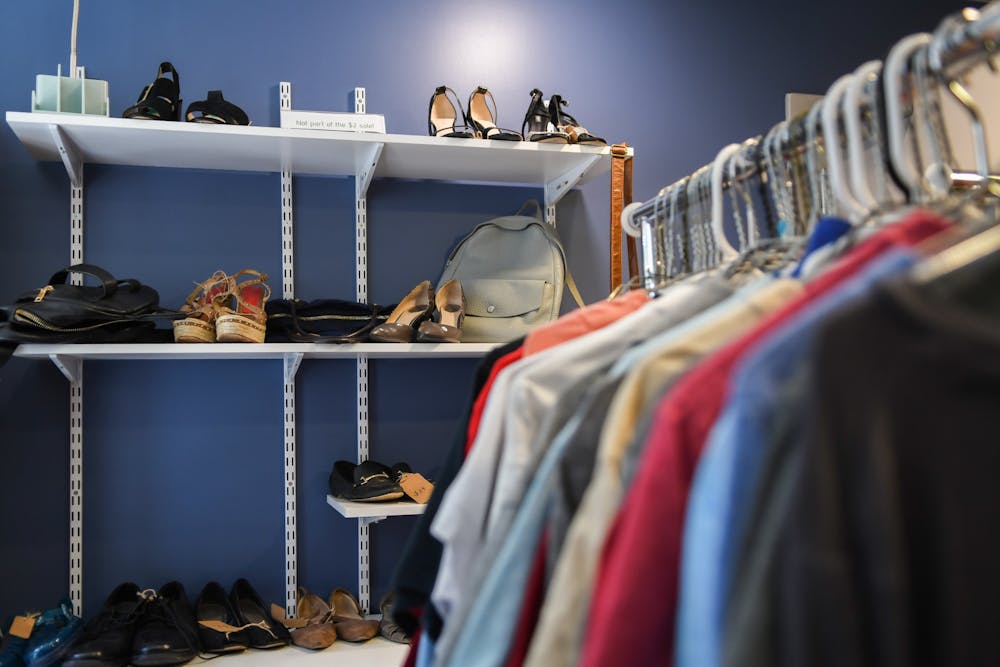“We should definitely go thrifting together!” This is a line that I’ve heard a thousand times during small talk with strangers-turned-acquaintances at Penn. Young people see thrifting as a fun way to establish a unique sense of style while promoting environmental sustainability in an age of made-for-the-landfill clothing and trends.
However, with the end of Penn's Climate Week, it’s important for us to consider what sustainability really means, especially in an industry as dominant as fashion. Although thrifting provides clothes with longer lifespans and is considered a lesser evil to fast fashion, it should not be viewed as the end-all to the issues of carbon emissions and waste in our traditional fashion industry.
Aided by social media influencers and internet trends, second-hand shopping has made a huge breakthrough in the youth fashion industry in the past few years, with the global second-hand market being expected to almost double by 2027 and reach $350 billion.
Compare the fast fashion industry’s carbon footprint with one of Bigfoot’s summer sandals, and I’m sure it will be hard to tell the difference. The overproduction of clothing results in colossal amounts of carbon emissions and waste. Around 80% of all clothing either goes straight to the landfill or is incinerated. Furthermore, it is estimated that while the lifespan of clothes has been cut in half, humans are buying 60% more clothes than ever before. As companies produce staggering amounts of clothes and carbon emissions, we consume more in shorter amounts of time.
Because of the detrimental environmental impact of fast fashion, it is clear why many of us are seeking more sustainable alternatives. In fact, nine in ten Gen Z consumers believe companies have a responsibility to address environmental and social issues.
However, is thrifting really as sustainable as we think?
From Depop resellers to “thrifting influencers”, social media is crowded with a glorification of the overconsumption of second-hand clothing. Social media stars post themselves at Goodwill every week loading up their carts with any sort-of ugly piece of clothing that they believe has potential. Following their lead, gaggles of people (myself included) dig through thrift racks sniffing for this potential, buying clothes that don’t fit just to tear them up at home with a pair of kitchen scissors, interesting purses that we all had to have but ended up never using, and bits and pieces of a Halloween costume left untouched, rotting in the back of the closet. Thrifting seems to be a win-win situation for the people walking out of thrift stores with their stuffed tote bags: now, they can both fulfill their consumerist desires while patting themselves on the back for avoiding fast fashion and saving the environment!
We have brought our fast-fashion mindset into thrift shops. Shopping second-hand has become our justification for buying an excessive amount of unnecessary clothing items as we ignore our consumption habits. This negatively affects the low-income populations that use the thrift store for cheaper necessities such as winter coats and shoes. Just like many other areas in the world, thrifting in Philadelphia has become a gentrified space, with prices of clothes rising as wealthier people infiltrate thrift shops to buy clothes in excess. The low prices in thrift stores that used to cater towards lower-income populations now incentivize people with higher spending power to purchase items they may not even need.
SEE MORE FROM THE DAILY PENNSYLVANIAN:
Ace Dahyeon Choi | Fashion and you
Alex Baxter | Style versus substance: Finding identity at Penn and beyond
Furthermore, the rise of thrifting is encouraging a cycle of donating untrendy pieces for a chance to revamp a wardrobe with more fast fashion items. The false sense of guiltlessness that results from donating unwanted clothes to Salvation Army or Goodwill tricks us into thinking that we can buy new clothes from retail shops without any environmental consequences.
It might be time for us to confront the hard fact that thrifting just may be the newborn baby of fast fashion and consumer culture, fed by the castoffs of overproduction and swaddled by quick-turning trends. However, shopping second-hand is still the lesser evil of the fashion industry. What we should do is thrift consciously and keep our overconsumption in check while making sure we are leaving necessities for lower-income groups in the area.

CHLOE CHEN is a College first-year studying economics and international relations from Vancouver, Canada. Her email is chloeec@sas.upenn.edu.
SEE MORE FROM THE DAILY PENNSYLVANIAN:
Ace Dahyeon Choi | Fashion and you
Alex Baxter | Style versus substance: Finding identity at Penn and beyond









